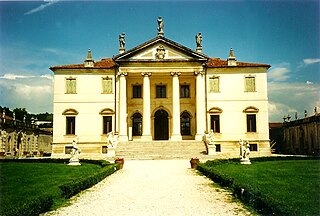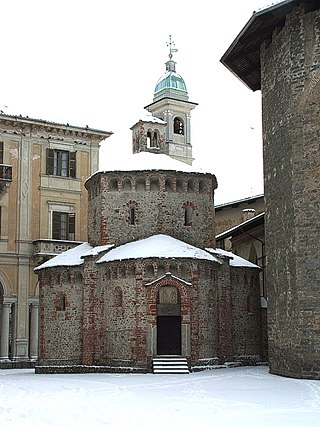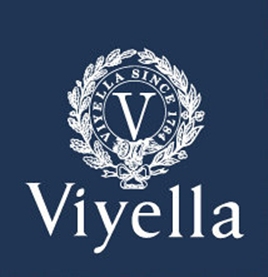Compagnie Financière Richemont S.A., commonly known as Richemont, is a Switzerland-based luxury goods holding company founded in 1988 by South African businessman Johann Rupert. Through its various subsidiaries, Richemont produces and sells jewellery, watches, leather goods, pens, firearms, clothing, and accessories. Richemont is publicly traded as CFR on the SIX Swiss Exchange and the JSE.

The province of Vicenza is a province in the Veneto region of Italy. Its capital city is Vicenza.

Biella is a city and comune (municipality) in the northern Italian region of Piedmont, the capital of the province of the same name, with a population of 44,324 as of 31 December 2017. It is located about 80 kilometres northeast of Turin and at about the same distance west-northwest of Milan.

L.R. Vicenza, commonly referred to as Vicenza, is an Italian football club based in Vicenza, Veneto. Founded in 1902 as Associazione del Calcio in Vicenza, they became Lanerossi Vicenza in 1953, then Vicenza Calcio from 1990 to 2018, a year which saw the club going bankrupt and being put under controlled administration to preserve the Serie C spot at the end of the 2017–18 season. Renzo Rosso, owner of fashion brand Diesel, merged its Bassano Virtus and some of the assets of Vicenza Calcio into one team, L.R. Vicenza Virtus, which will play in Vicenza, while the two sides will preserve their distinct youth teams. Vicenza is the oldest team in Veneto; officially founded on 9 March 1902 by the then dean of Liceo Lioy, Tito Buy, and the physical education teacher of the same school, Libero Antonio Scarpa.
Ermenegildo Zegna N.V., also known as Zegna or the Ermenegildo Zegna Group, is an Italian luxury fashion house. It was founded in 1910 by Ermenegildo Zegna in Trivero, Biella, in the Piedmont region of northern Italy. As of 2021, it is a public company that is listed on the New York Stock Exchange.

Schio is a town and comune in the province of Vicenza situated north of Vicenza and east of the Lake Garda. It is surrounded by the Little Dolomites and Mount Pasubio.

Hugo Boss AG is a fashion company headquartered in Metzingen, Baden-Württemberg, Germany. The company sells clothing, accessories, footwear, and leather goods. Hugo Boss is one of the largest German clothing brands, with global sales of about €4.2 billion in 2023. Its stock is a component of the MDAX. The company's fashion brands are Boss and Hugo. Hugo Boss also sells licensed brand products for children's fashion, eyewear, watches, home textiles, riding apparel, writing utensils and fragrances.
Cerruti 1881, also known as Cerruti, is an Italian luxury fashion house founded in 1967 and headquartered in Paris. It was founded by the Italian stylist and fashion producer Nino Cerruti. It was named "1881" because Nino's grandfather established the family woolen mill, Fratelli Cerruti Wool Mill, in Italy in 1881.
Nino Cerruti was an Italian businessman and stylist. He founded his own haute couture house, Cerruti 1881, in 1967 in Paris. He managed the Italian family business Lanificio Fratelli Cerruti, which was founded in 1881 by his grandfather.

Viyella is a blend of wool and cotton first woven in 1893 in England, and the "first branded fabric in the world". It was made of 55% merino wool and 45% cotton in a twill weave, developed by James and Robert Sissons of William Hollins & Co, spinners and hosiers. The brand name, first registered as a trademark in 1894, and registered in the United States in 1907, soon covered not only the original fabric, to be sold by the yard, but also clothing. At first this was made by separate businesses, but it was not long before Hollins started producing their own clothes and offering franchises to manufacturers who would use the Viyella label. Following increasing emphasis on garment manufacture over the years, Viyella is now a fashion brand for clothes and home furnishings made of a variety of fabrics. The original wool/cotton blend is no longer sold.
The Marzotto Group is an Italian textile manufacturer, based in Valdagno.

Valentino S.p.A. is an Italian luxury fashion house founded in 1960 by Valentino Garavani and part of the Valentino Fashion Group. From October 2008, the creative director is Pierpaolo Piccioli, jointly with Maria Grazia Chiuri from 2008 to 2016. Piccioli departed Valentino in 2024. The company is headquartered in Milan, while the creative direction is in Rome. The Valentino Beauty license is held by L'Oreal.
Italy is one of the leading countries in fashion design, alongside France and the United Kingdom. Fashion has always been an important part of the country's cultural life and society, and Italians are well known for their attention to dress; la bella figura, or good appearance, retains its traditional importance.

The history of Italian fashion is a chronological record of the events and people that impacted and evolved Italian fashion into what it is today. From the Middle Ages, Italian fashion has been popular internationally, with cities in Italy producing textiles like velvet, silk, and wool. During the Middle Ages and Renaissance, Italian fashion for both men and women was extravagant and expensive, but the fashion industry declined during the industrialization of Italy. Many modern Italian fashion brands were founded in the late 19th and early 20th centuries, and in the 1950s and 1960s, Italian fashion regained popularity worldwide. While many clients of Italian fashion designers are celebrities, Italian fashion brands also focus on ready-to-wear clothes.

Vionnet is an haute couture label founded by the French couturier Madeleine Vionnet. Established in 1912, the house of Vionnet closed doors in 1939. Vionnet was relaunched by Guy and Arnaud de Lummen in the mid-1990s with perfumes and accessories, and then in 2006 with ready-to-wear collections. In 2012, Vionnet was purchased by the Kazakh businesswoman Goga Ashkenazi. In 2023, Chimhaeres Investments purchased the brand.

Vitale Barberis Canonico (VBC) is an Italian fabric mill that was established in 1663. It is located in Pratrivero, about 50 miles northeast of Turin in the Piedmont region of northwest Italy.
Reda Group is an Italian wool mill established in 1865 by Carlo Reda. The mill is located in Valdilana, in the historic Biella region.

Giuseppe Eugenio Luraghi was an Italian automobile executive, mechanical engineer, writer and poet. He is mostly known for his association with Alfa Romeo, where he was president.

Nicolò Tron was an Italian politician, businessman and agronomist, citizen of the Republic of Venice.

Alessandro Rossi was an Italian textile industrialist and politician. He introduced technological innovation for manufacturing wool in Schio, Veneto. He inherited the wool mill Lanificio Rossi from his father Francesco Rossi, and converted the company into one of the main industries of Italy. He was deputy and senator of the Kingdom of Italy.













